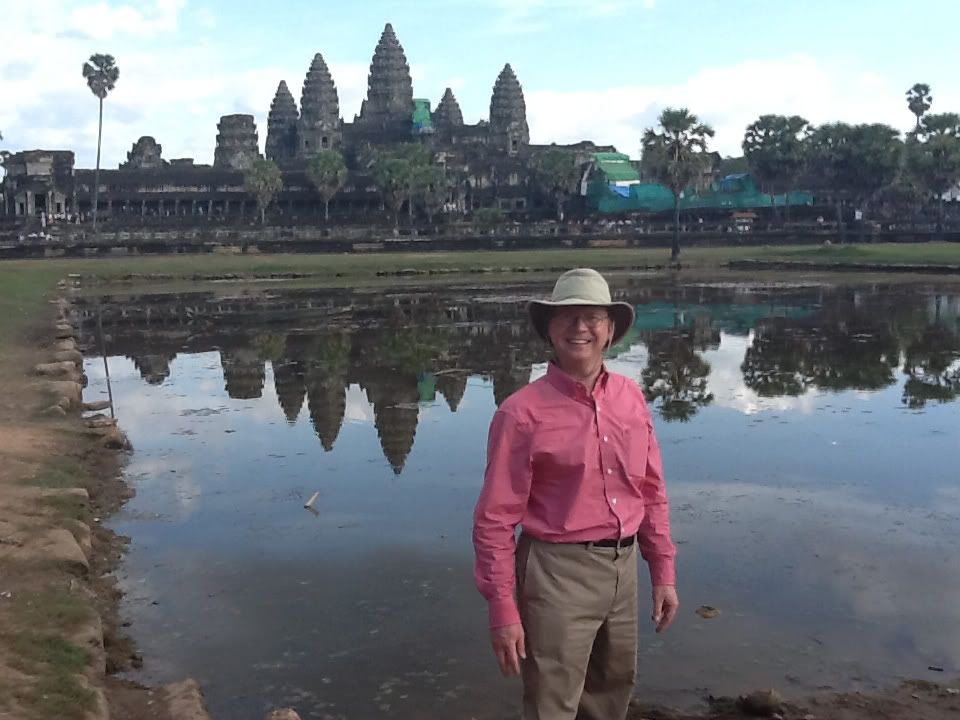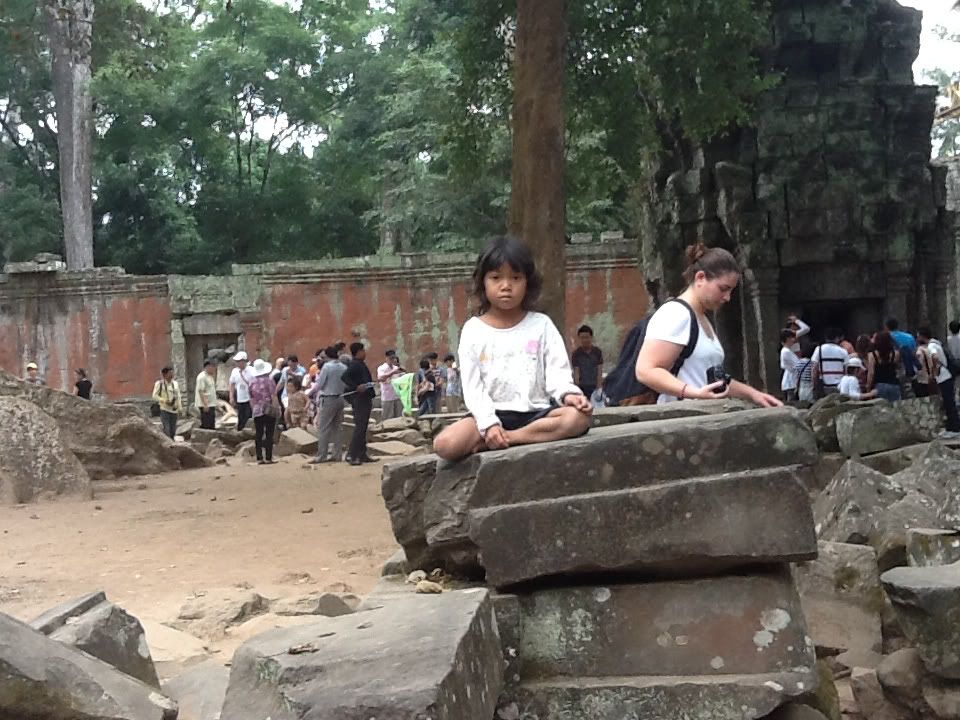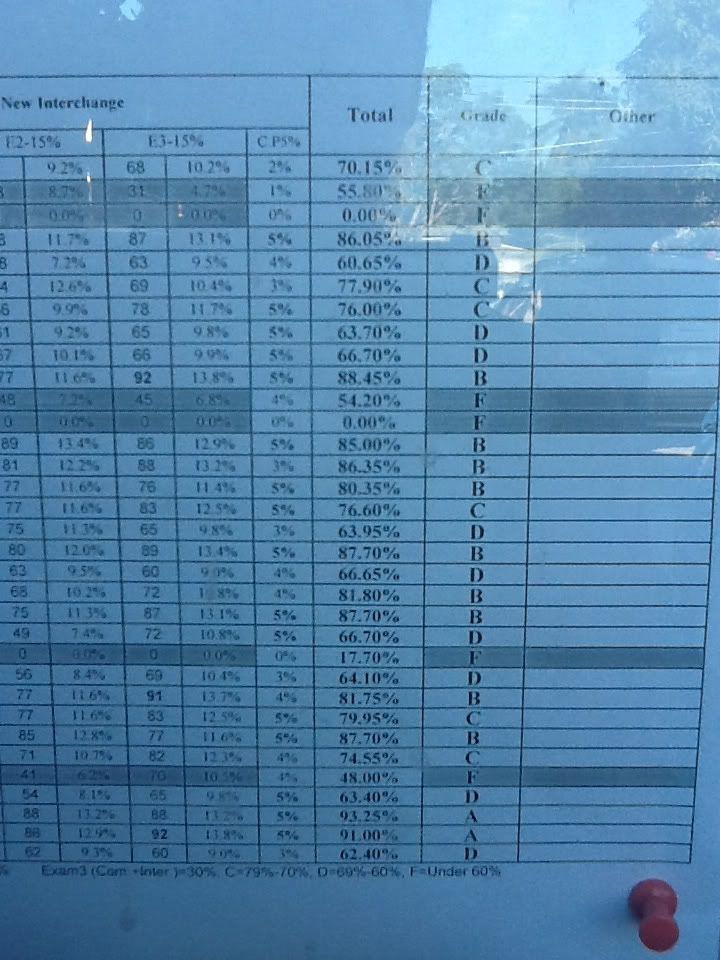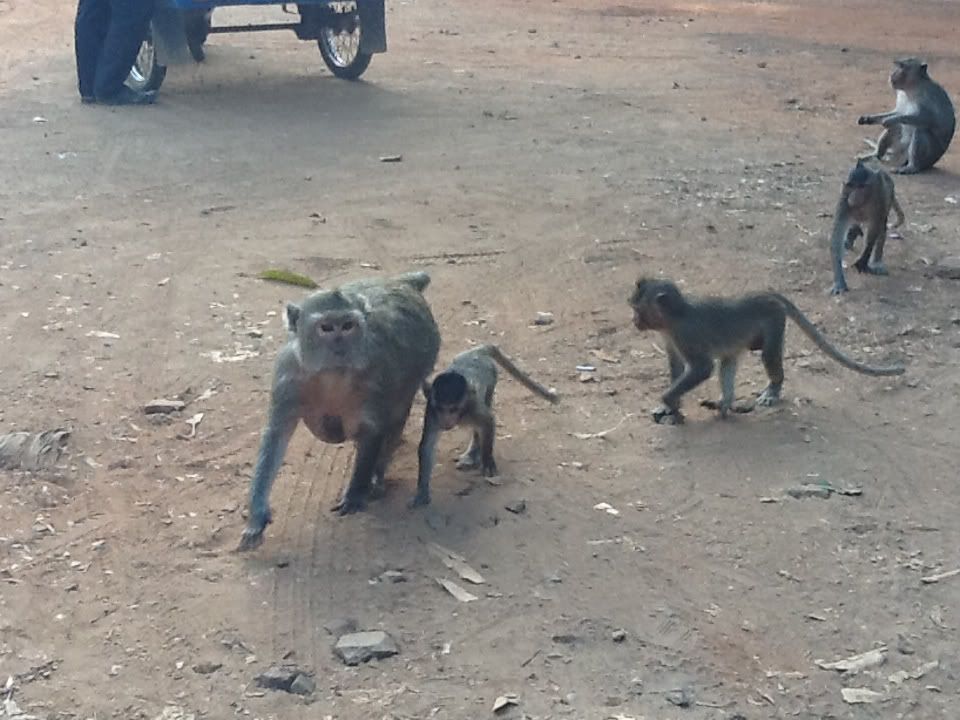This blog is set up in reverse chronological order. You may want to read the blog by going to the early entries first and then work your way up to the later entries.
I have spent an enjoyable and informative week in Cambodia attending the World History Association symposium in Siem Reap Cambodia. I hope that this blog can give readers a small taste of the experience that I enjoyed. Some of the entries deal with ancient Cambodian history and architecture, some deal with the tragic history of Cambodia's recent past, and others deal with the simple observations of a curious traveller.
I would like to give thanks to Mrs. Pullen, Dr. Watts, and Mrs. Wolcott for letting me take the time away from school to have this professional development opportunity.
For providing me professional inspirations: my colleagues at Saint Stephen’s, my colleagues in the AP World History community, and my students.
For filling in the gaps in my absence: my wife Heather, my sons Kyle and John, Mr. Zappa, and Mrs. Pommer.
For being my tour guide and encouraging me to come to Cambodia: Marc Gilbert who is the president-elect of the World History Association.
I would also like to extend gratitude to the kind and generous people of Cambodia, who seem to have a gentle approach to life despite the tragedies of recent years.
Tuesday, January 3, 2012
Symposium sessions
I attended six sessions of about 90 minutes each at the World History Association symposium and listened to a total of 20 presentations by scholars in the field of Southeast Asian history.
I was the chair of one of the panels, so my responsibility was to introduce the speakers, hold them to their time limits, and lead discussion. Typically chairs are prominent people in the field. I was the only high school teacher who chaired a panel, which was a great honor.
Some interesting topics included:
A paper on the role of Singapore as a transit point for SE Asian Muslims making their pilgrimage to Mecca. The professor talked about the web of brokers and dealers who would exchange Hajj travel for forced labor. Two years on a plantation was a typical cost for a pilgrimage for an impoverished Hajji.
A professor from the US Naval Academy discussed the issue of food security in the Middle East and how Arab countries are buying up huge plots of land in SE Asia for their own food needs. This process is resulting in more food scarcity in places like Cambodia.
A professor from Pakistan discussed the similarities between Islam and Buddhism, which is of particular importance for my World History students who wrote an essay on that topic for their semester exam. He, a devout Muslim, suggested that Buddha could have been an early prophet of Allah since his teachings are so similar to those later revealed by Muhammad. Wow.
In my session an architect showed how the capital Phnem Penh has been transformed because of flooding on the Mekong River. She showed changes over time from the early French colonial period and comparisons to New Orleans after Katrina. I might use her work for a lesson in AP World History on recent issues concerning the interaction of humans and the environment.
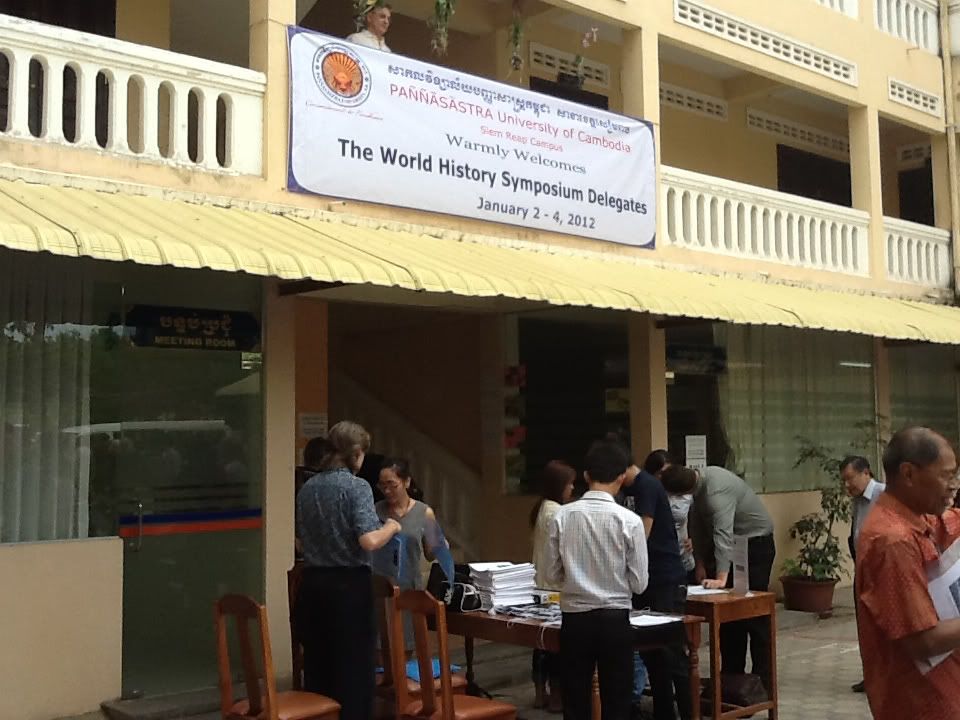
I was the chair of one of the panels, so my responsibility was to introduce the speakers, hold them to their time limits, and lead discussion. Typically chairs are prominent people in the field. I was the only high school teacher who chaired a panel, which was a great honor.
Some interesting topics included:
A paper on the role of Singapore as a transit point for SE Asian Muslims making their pilgrimage to Mecca. The professor talked about the web of brokers and dealers who would exchange Hajj travel for forced labor. Two years on a plantation was a typical cost for a pilgrimage for an impoverished Hajji.
A professor from the US Naval Academy discussed the issue of food security in the Middle East and how Arab countries are buying up huge plots of land in SE Asia for their own food needs. This process is resulting in more food scarcity in places like Cambodia.
A professor from Pakistan discussed the similarities between Islam and Buddhism, which is of particular importance for my World History students who wrote an essay on that topic for their semester exam. He, a devout Muslim, suggested that Buddha could have been an early prophet of Allah since his teachings are so similar to those later revealed by Muhammad. Wow.
In my session an architect showed how the capital Phnem Penh has been transformed because of flooding on the Mekong River. She showed changes over time from the early French colonial period and comparisons to New Orleans after Katrina. I might use her work for a lesson in AP World History on recent issues concerning the interaction of humans and the environment.

Education in Cambodia
I was talking with an educational expert from an American NGO (non-governmental organization).
He described the school system as being profoundly unfair. First, teachers are underpaid. Each earns about $90 a month. To make more money, almost all teachers tutor students after class. They typically tutor their own students, which leads to a conflict of interest. Many families think that if they don't get tutoring, the teacher will fail the student. Often this is the case.
Although schooling is mandatory, most kids don't go to class. Their labor is needed by the family, and tutoring is out of the question for all but the well off. Also almost everyone over a certain age is uneducated because the purges of the Khmer Rouge targeted educated people. Some families just don't see the value.
Cambodia is a country of young people. I saw school-aged kids everywhere who were certainly outside of the school system. Many of them were doing labor such as working market stalls, selling trinkets, and such. Others were just hanging around, not playing or doing much of anything.
The image below is of a girl at the Ta Prohm temple.
He described the school system as being profoundly unfair. First, teachers are underpaid. Each earns about $90 a month. To make more money, almost all teachers tutor students after class. They typically tutor their own students, which leads to a conflict of interest. Many families think that if they don't get tutoring, the teacher will fail the student. Often this is the case.
Although schooling is mandatory, most kids don't go to class. Their labor is needed by the family, and tutoring is out of the question for all but the well off. Also almost everyone over a certain age is uneducated because the purges of the Khmer Rouge targeted educated people. Some families just don't see the value.
Cambodia is a country of young people. I saw school-aged kids everywhere who were certainly outside of the school system. Many of them were doing labor such as working market stalls, selling trinkets, and such. Others were just hanging around, not playing or doing much of anything.
The image below is of a girl at the Ta Prohm temple.
No grade inflation in Cambodia
Hotel with kitsch art
On the first day of the symposium, we had a reception in the courtyard of a highly unusual hotel. A handful of modern artists from Cambodia and Thailand were given free reign to design rooms and outdoor spaces as they saw fit. The result was a collection of clever kitsch. One of the rooms had a Barbie theme with dolls and accessories displayed throughout a bright pink room. My favorite room was named "what cats dream." It had lighthearted sketches of mice, birds and such.
Below is a photo of a couch made from small stuffed animals from the hotel lobby.
The hotel restaurant was good and inexpensive. The most expensive meal on the menu cost $3.
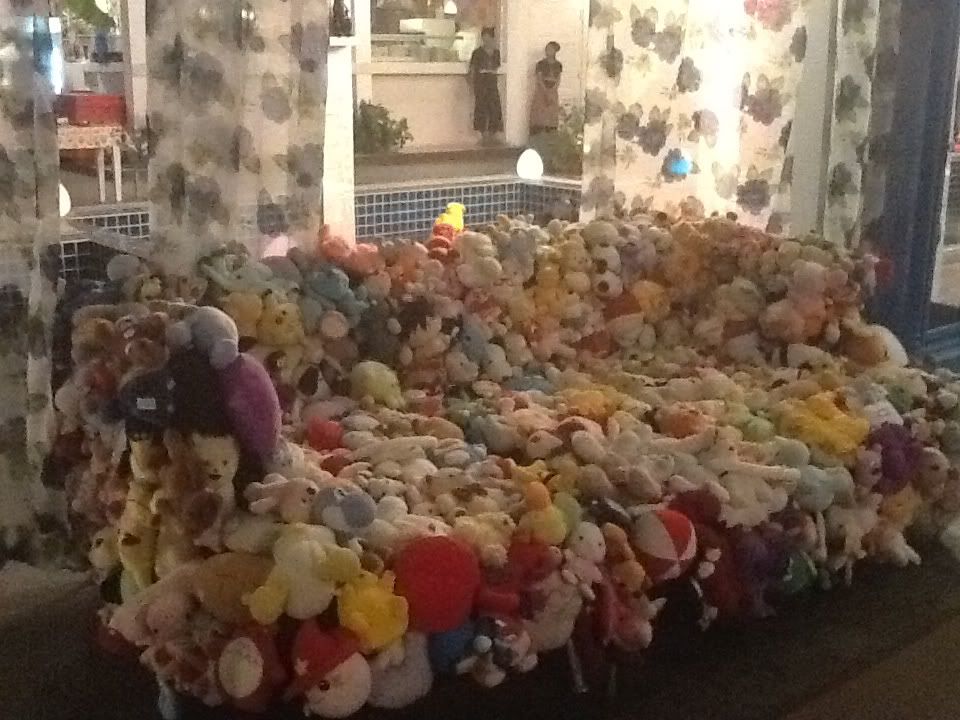
Below is a photo of a couch made from small stuffed animals from the hotel lobby.
The hotel restaurant was good and inexpensive. The most expensive meal on the menu cost $3.

A university library
Pannasastra University is regarded as one of the best in Cambodia outside of the capital. However, like all educational institutions in Cambodia, it had to start from scratch less than 20 years ago.
The place where its youth is most evident is its library. The image below shows the total collection of books on its main campus. In scanning the shelves I discovered that almost all of the books were used books from personal collections. The Goosebumps series was well represented, which makes sense for a campus that also hosts English lessons for teenagers.
On the suggestion of the organizer of the symposium, I brought two books to donate to the library. Both were given to me gratis by a textbook publisher. I thought that a psychology book and an American government book would be of interest.
Pannasastra University is an English-speaking university. All classes are in English, and all books in the library seemed to be in English.
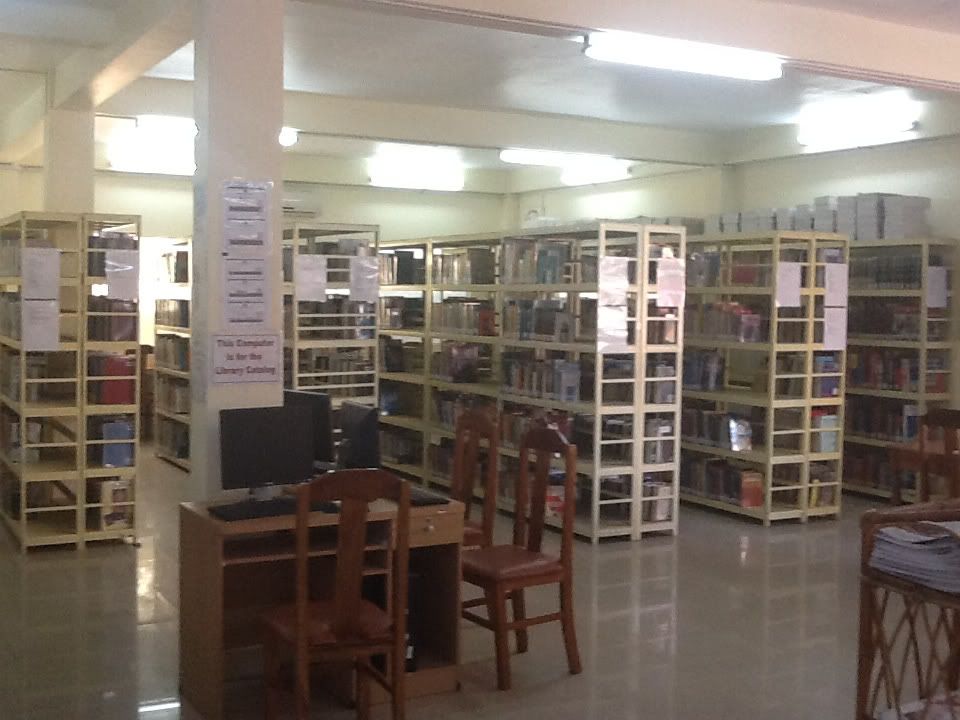
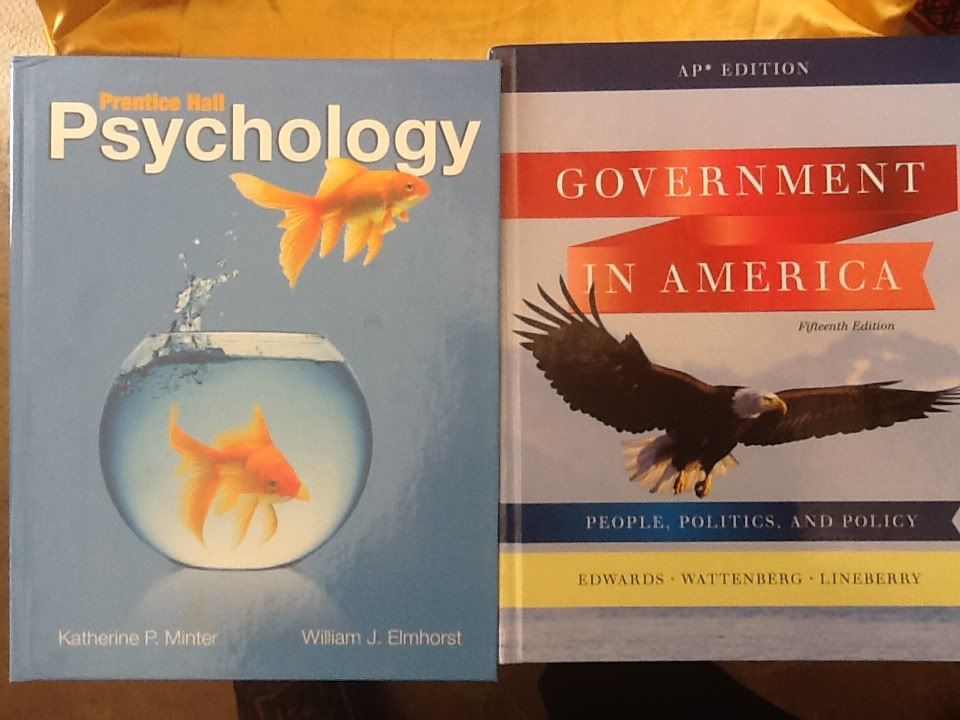
The place where its youth is most evident is its library. The image below shows the total collection of books on its main campus. In scanning the shelves I discovered that almost all of the books were used books from personal collections. The Goosebumps series was well represented, which makes sense for a campus that also hosts English lessons for teenagers.
On the suggestion of the organizer of the symposium, I brought two books to donate to the library. Both were given to me gratis by a textbook publisher. I thought that a psychology book and an American government book would be of interest.
Pannasastra University is an English-speaking university. All classes are in English, and all books in the library seemed to be in English.


Pannasastra University
Pannasastra University in Siem Reap was our hosting institution for the symposium.
It has in total many hundred students in various branch campuses and part-time programs.
The main campus is about the size of Saint Stephen's Upper School. Classrooms seat many students, and classes are offered at times throughout the day and night.
Tuition is steep for a typical Cambodian family: a couple hundred dollars per semester.
As you can see from the list below, it thinks pretty highly of itself. At least Yale University made the list.
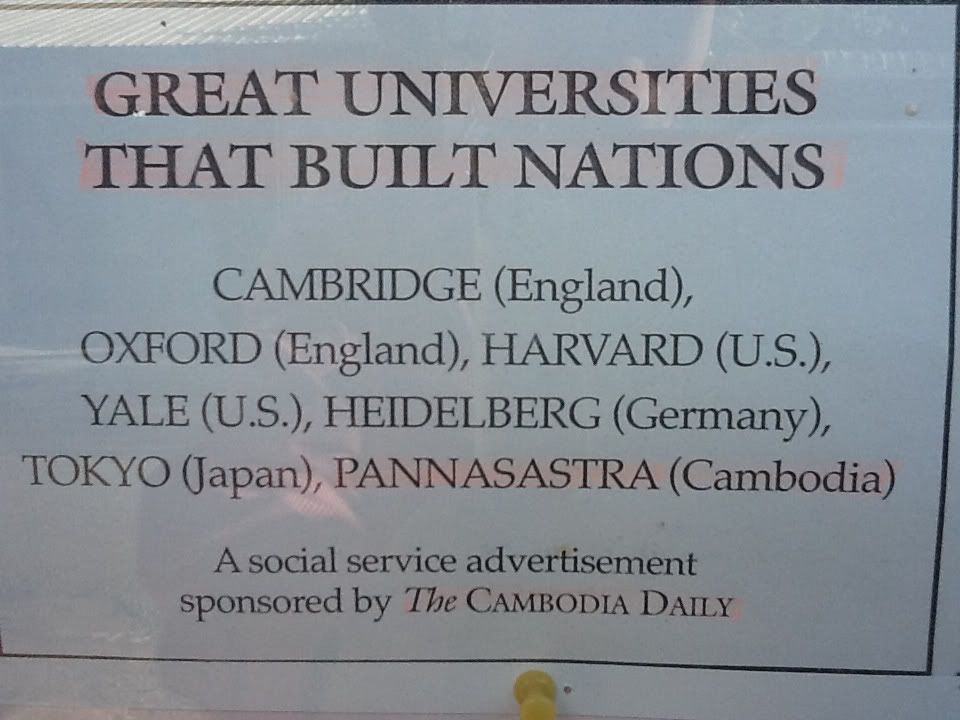
It has in total many hundred students in various branch campuses and part-time programs.
The main campus is about the size of Saint Stephen's Upper School. Classrooms seat many students, and classes are offered at times throughout the day and night.
Tuition is steep for a typical Cambodian family: a couple hundred dollars per semester.
As you can see from the list below, it thinks pretty highly of itself. At least Yale University made the list.

The symposium starts
A main reason why I went to Cambodia is to attend the World History symposium on Southeast Asian history.
A symposium is a scholarly conference in which researchers present their findings to groups of their peers. The true benefits come outside of the panels when people get to meet other people who are pursuing like interests. Plenty of interesting people abound. Even though most of them teach in colleges and major universities, I enjoy putting myself in the midst of conversations and meeting these interesting people.
I attended my last WHA symposium in Istanbul, Turkey last October.
You can follow my Istanbul blog here.
About seventy scholars came for the symposium. Most are Americans, but a substantial number came from Europe and Asia.
We met as a large group only a few times. Before our first session I took this picture of one of the simple classrooms at the university that was hosting us. Many of the people in the image I got to know fairly well.

A symposium is a scholarly conference in which researchers present their findings to groups of their peers. The true benefits come outside of the panels when people get to meet other people who are pursuing like interests. Plenty of interesting people abound. Even though most of them teach in colleges and major universities, I enjoy putting myself in the midst of conversations and meeting these interesting people.
I attended my last WHA symposium in Istanbul, Turkey last October.
You can follow my Istanbul blog here.
About seventy scholars came for the symposium. Most are Americans, but a substantial number came from Europe and Asia.
We met as a large group only a few times. Before our first session I took this picture of one of the simple classrooms at the university that was hosting us. Many of the people in the image I got to know fairly well.

United States' secret war
Towards the end of the Vietnam War, Richard Nixon expanded the war into Cambodia. The secret war started with a massive bombing campaign followed by tens of thousands of troops. It was an illegal war because the US did not get Congressional approval like it did later for the wars in Iraq or Afghanistan.
The purpose of the early blanket bombing campaign was to stop the supply routes of the Vietcong enemy. More tons of bombs fell in Cambodia and Vietnam during this period than all of the bombs used by the US in World War II against Germany and Japan. Militarily it was a failure.
Before I left for Cambodia, a friend said that I would be very impressed by the beauty of the country. When I asked when he had traveled there, he said that he was deployed in Cambodia during the 1970s. He said that soldiers traveled deep into the country and could visit pretty much anywhere in Cambodia.
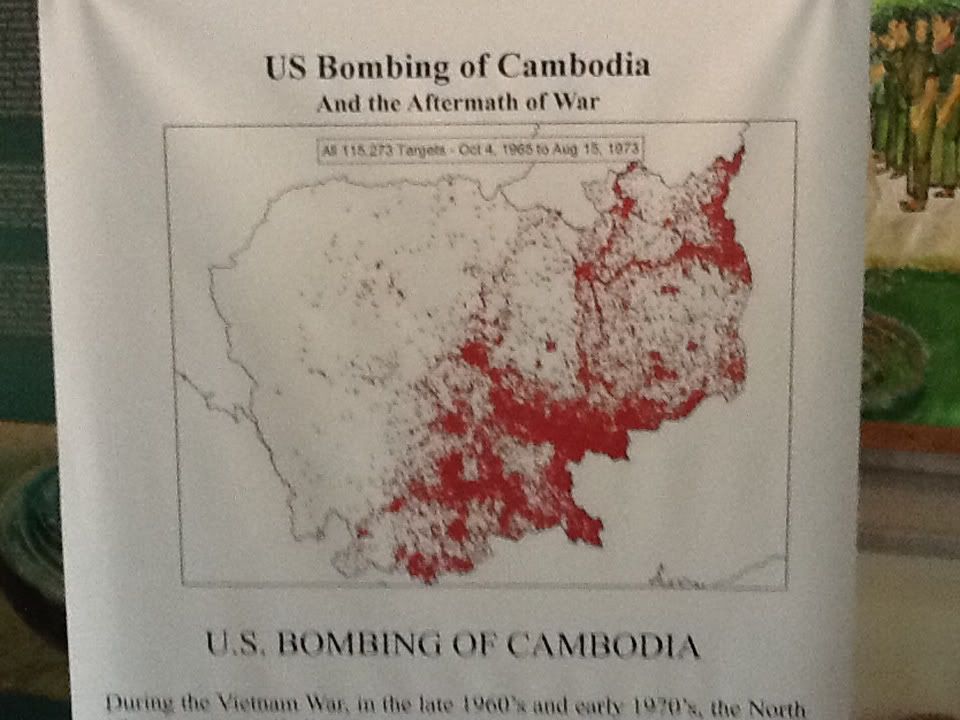
The purpose of the early blanket bombing campaign was to stop the supply routes of the Vietcong enemy. More tons of bombs fell in Cambodia and Vietnam during this period than all of the bombs used by the US in World War II against Germany and Japan. Militarily it was a failure.
Before I left for Cambodia, a friend said that I would be very impressed by the beauty of the country. When I asked when he had traveled there, he said that he was deployed in Cambodia during the 1970s. He said that soldiers traveled deep into the country and could visit pretty much anywhere in Cambodia.

More about landmines
One of the stops that we made was at the Cambodian landmine museum.
The museum was founded by a former child soldier of the Khmer Rouge. He was considered his unit's best sharpshooter at the age of ten. He switched sides and developed a remarkable ability to defuse landmines with simple tools.
More on the founder of the landmine museum.
The images below show just a small number of the mines and unexploded shells that he has defused.
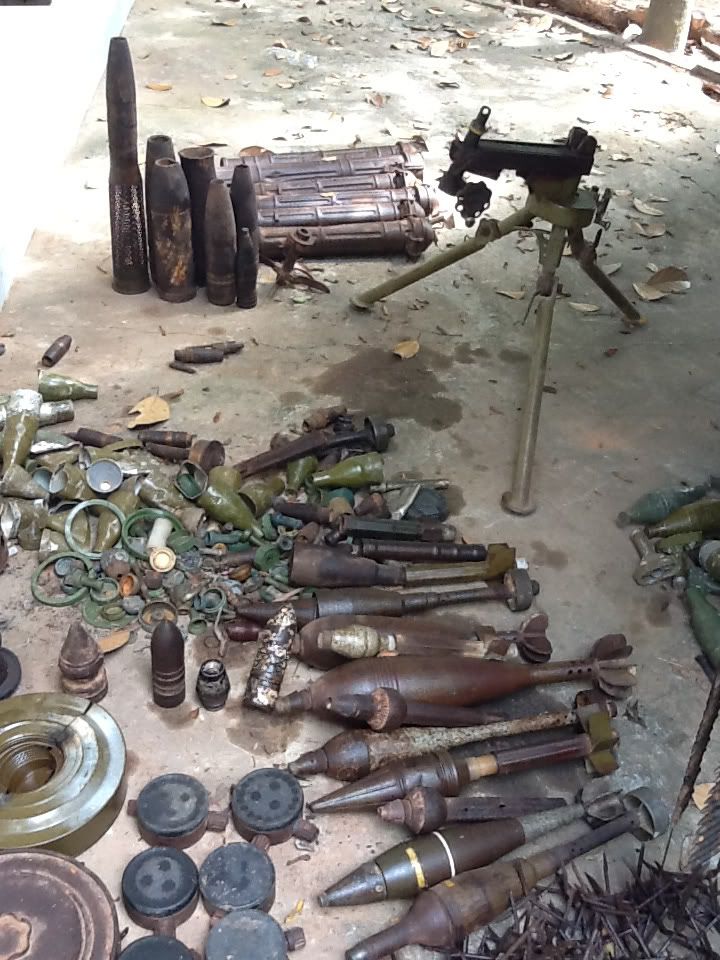
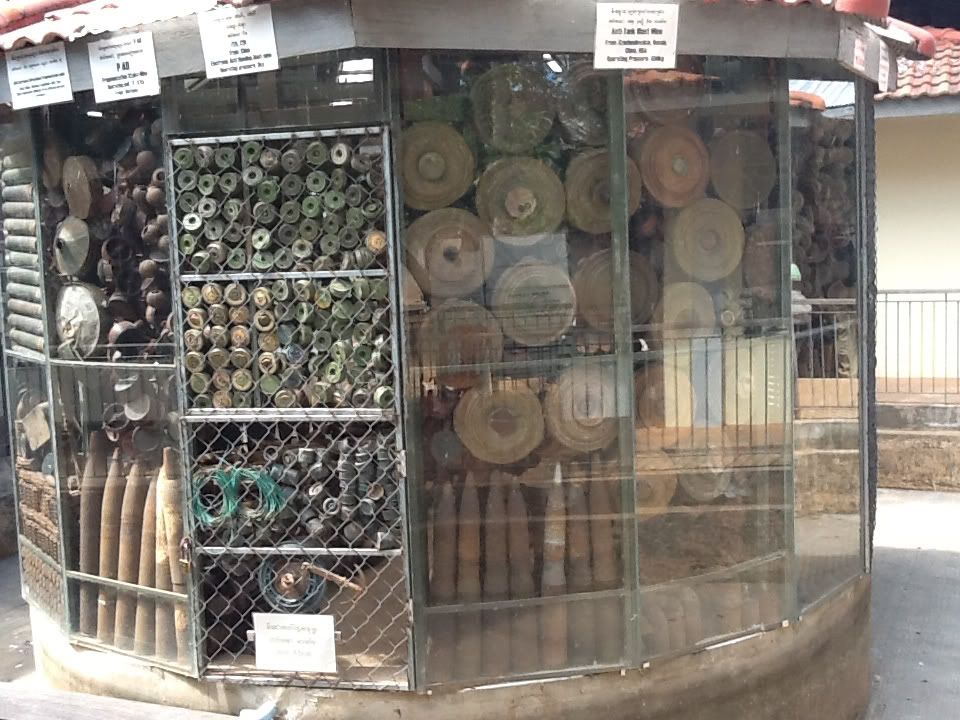
The museum was founded by a former child soldier of the Khmer Rouge. He was considered his unit's best sharpshooter at the age of ten. He switched sides and developed a remarkable ability to defuse landmines with simple tools.
More on the founder of the landmine museum.
The images below show just a small number of the mines and unexploded shells that he has defused.


Sanskrit
The language of Cambodia is Khmer, which is a distant relative of Sanskrit. Sanskrit comes from India and was widely used by the ancient Khmer empire. Cambodia derives much of its culture, religion, and language from India because of the Indian Ocean trade system.
This image was the only piece of writing that I saw in any of the temples. It is written in the Sanskrit language.
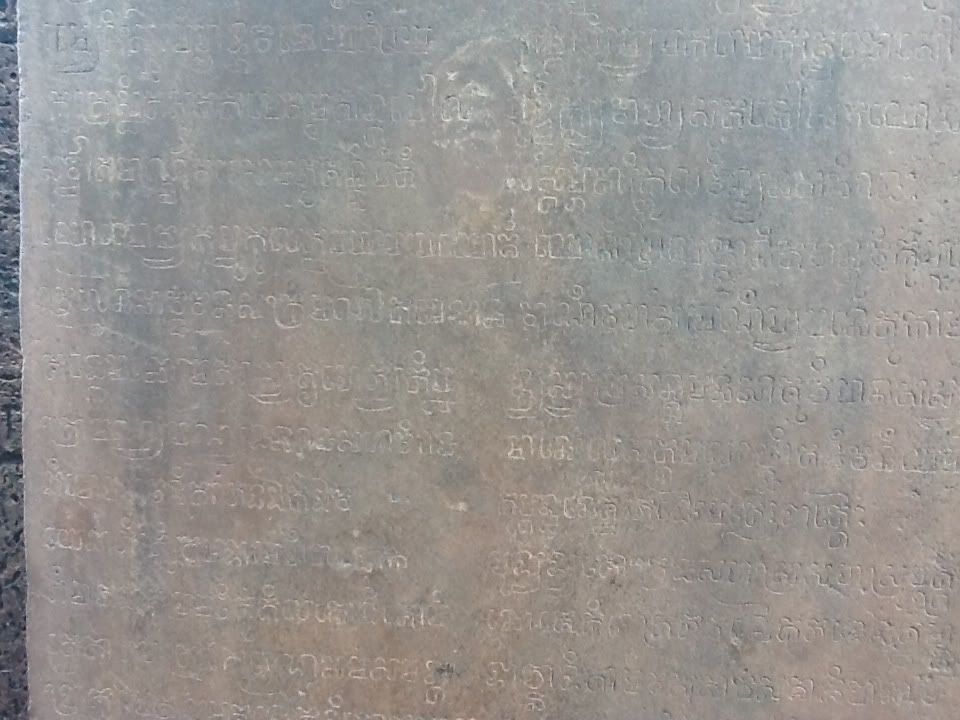
This image was the only piece of writing that I saw in any of the temples. It is written in the Sanskrit language.

The Center for Khmer Studies
Our group of historians visited a Buddhist pagoda and research center in downtown Siem Reap. It was lovely--an oasis in the middle of a bustling city.
In the library was a wall painting of the setting around the Buddha when he meditated under the Bo tree and received enlightenment.
Notice the bullet holes in the wall. Those occurred most likely during the 1970s. During that time the Khmer Rouge evacuated the city and eliminated the population of Buddhist monks.
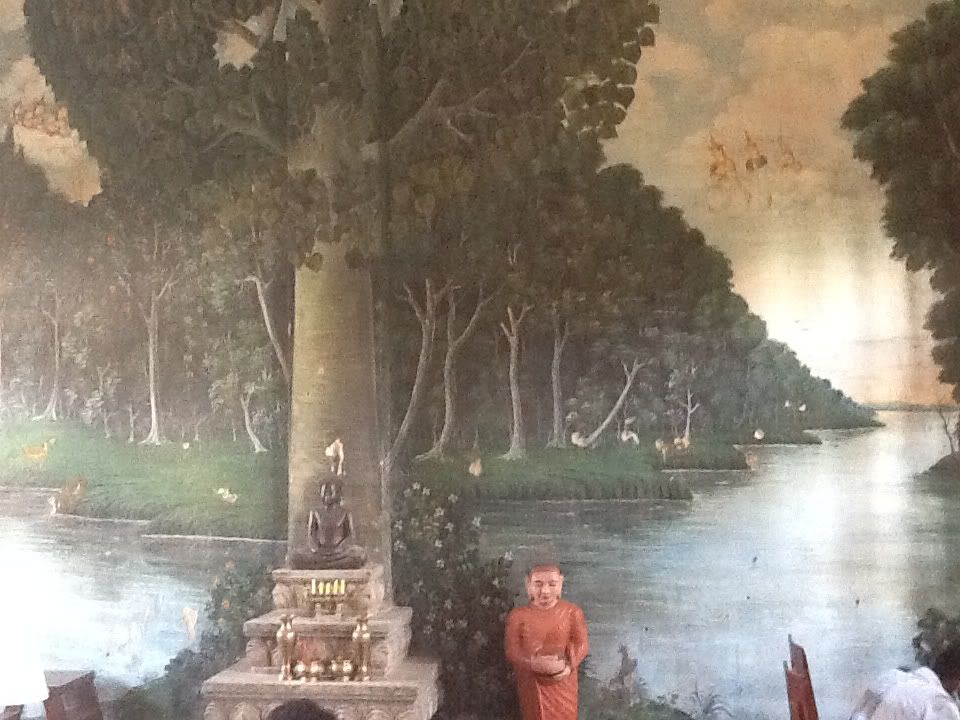
In the library was a wall painting of the setting around the Buddha when he meditated under the Bo tree and received enlightenment.
Notice the bullet holes in the wall. Those occurred most likely during the 1970s. During that time the Khmer Rouge evacuated the city and eliminated the population of Buddhist monks.

Household shrines
Religions in general and Buddhism in Cambodia in particular tend to be syncretic. In other words, they absorb influences from other cultures and tradition.
In Cambodia people erect gold-colored spirit houses for holding the spirits that have been displaced through the construction of the buildings. Small houses have small spirit houses, and large buildings have huge spirit houses.
Frequent offerings are made at these personal shrines. A historian that I spoke with suggested that this practice has its origins in the spiritualism that predates Buddhism in the region.
This spirit house was in front of the university where we held our symposium.
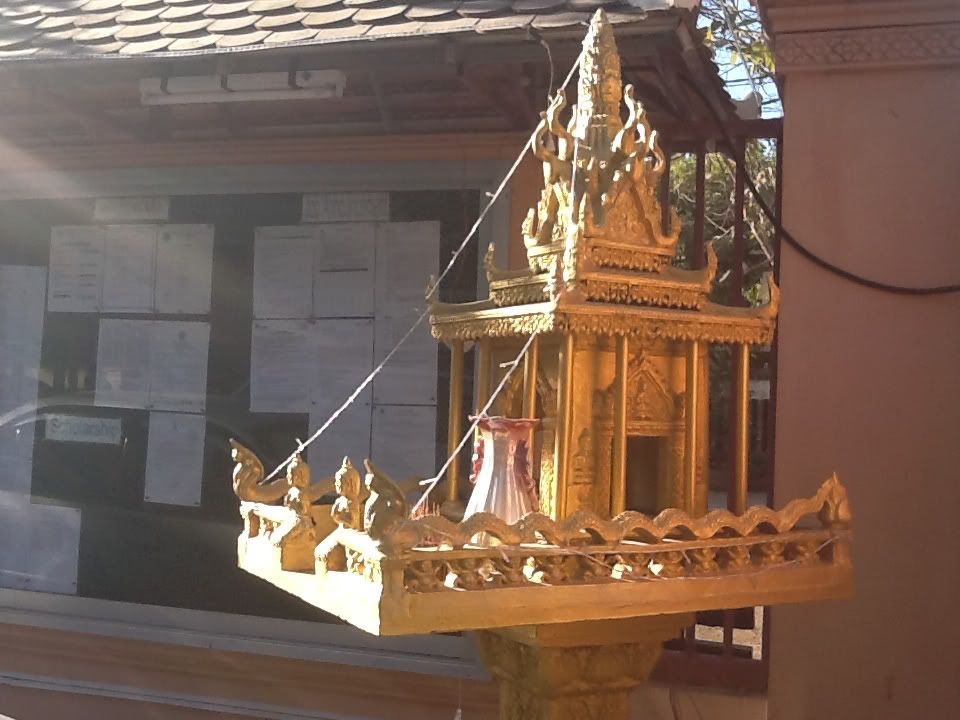
In Cambodia people erect gold-colored spirit houses for holding the spirits that have been displaced through the construction of the buildings. Small houses have small spirit houses, and large buildings have huge spirit houses.
Frequent offerings are made at these personal shrines. A historian that I spoke with suggested that this practice has its origins in the spiritualism that predates Buddhism in the region.
This spirit house was in front of the university where we held our symposium.

Active temples
At one of the temples that I visited a stupa stood in the center of the complex. A stupa is a Buddhist reliquary that often contains a small piece of the remains of the Buddha.
An incredibly small, fragile woman was in continual prayer next to the stupa. She would provide blessings to people who wanted one, such as this woman from our group. The pious Cambodian woman was also collecting money to support the neighboring monastery.
Much like the cathedrals of Europe, these temple complexes are places of worship today. Most, however, have not seen much religious use in the past several centuries.
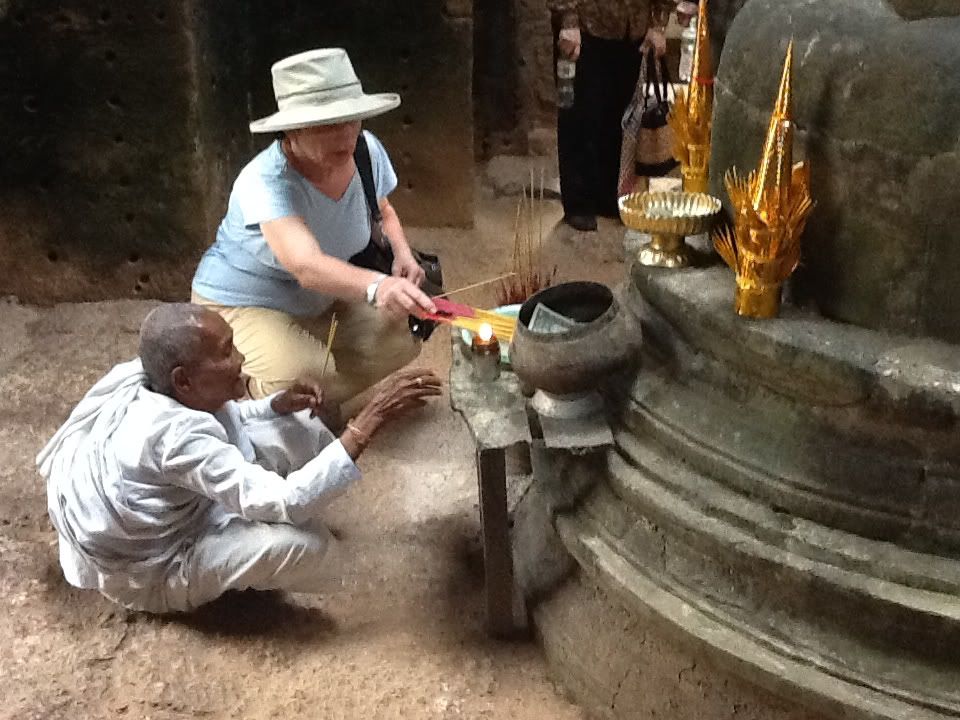
An incredibly small, fragile woman was in continual prayer next to the stupa. She would provide blessings to people who wanted one, such as this woman from our group. The pious Cambodian woman was also collecting money to support the neighboring monastery.
Much like the cathedrals of Europe, these temple complexes are places of worship today. Most, however, have not seen much religious use in the past several centuries.

Cambodian countryside
Cambodia is a profoundly agricultural country. I heard today that about 80% of households do not have access to the electrical grid. The average person makes about two dollars a day.
The first photo shows the countryside at its best. Since this is the dry season, lush fields were not common sights.
The second photo was taken out the window of a van. It shows about two-thirds of a typical country house. Note that all the living space is high off of the ground to compensate for the annual flooding.
Some historians suggest that the rural areas around this part of Cambodia supported a much larger population and had more sophisticated irrigation systems 900 years ago than today.

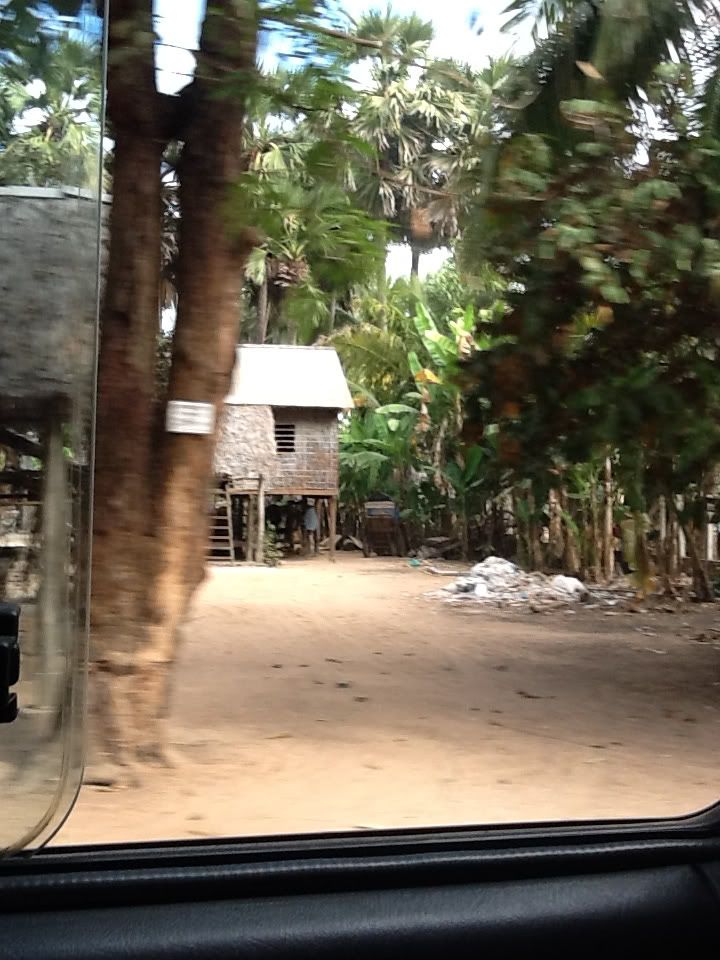
The first photo shows the countryside at its best. Since this is the dry season, lush fields were not common sights.
The second photo was taken out the window of a van. It shows about two-thirds of a typical country house. Note that all the living space is high off of the ground to compensate for the annual flooding.
Some historians suggest that the rural areas around this part of Cambodia supported a much larger population and had more sophisticated irrigation systems 900 years ago than today.


Gas station
Most vehicles in Cambodia have two wheels. Cars are on the streets, but motor scooters seem to outnumber them four to one.
Gas stations are quite different than those in Western countries. As you can see below, the gas is stored above ground in 55 gallon drums. Attendants pump the gas with a simple mechanical operation. Gas is also sold in two liter plastic bottles.
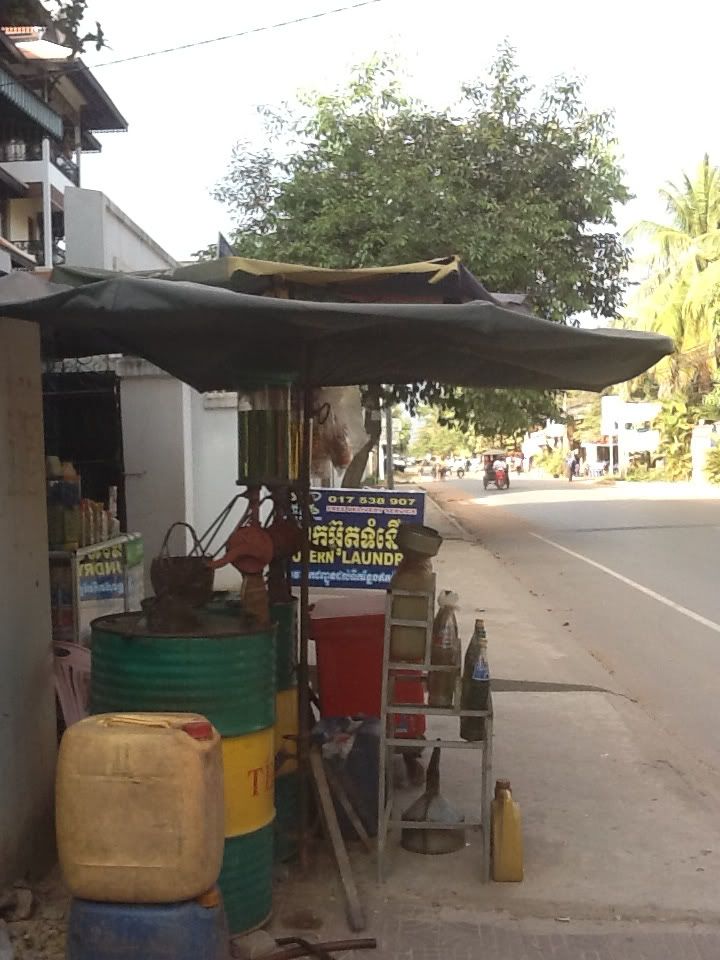
Gas stations are quite different than those in Western countries. As you can see below, the gas is stored above ground in 55 gallon drums. Attendants pump the gas with a simple mechanical operation. Gas is also sold in two liter plastic bottles.

Temple wall carvings
In my thinking before my trip, I expected to visit Angkor Wat since the architecture is one of a kind. The huge number of high quality temples beyond Angkor Wat surprised me. What also took me by surprise was the enormous role that wall carvings have in the artistic tradition of the Khmer Empire.
On several temples hundreds of feet of carvings grace the exterior walls. These temples were partially designed to be sites of religious pilgrimage for the masses. Although the general population came, the interior spaces were reserved for the imperial elite. For Hindu temples that would be the Brahmins. For Buddhist temples the elite might be the political elite.
Wall carvings on the outside of the temples, therefore, were meant to appeal to the masses and demonstrate the religious devotion of the Khmer imperial officials.
In a previous post I showed an image from the churning of the sea of milk that is at Angkor Wat.
The first two images are from Bayon Temple. The temple was dedicated after a Khmer king had defeated an army of Cham people from what is now Vietnam about 850 years ago. An enormous detailed wall of carvings depict the various stages of this campaign. It reminded me of Trajan's Column in Rome with similar scale and level of detail.
The next image is from Angkor Wat showing divine female dancers. These images are found all over the temple structures in this area. Traditional Cambodian dance troupes imitate the style of dance represented (but obviously not the dress).
The last image is from a small temple known for its exquisitely detailed carvings from Hindu mythology. The well preserved carvings were delightful since at every turn there was something else to marvel.

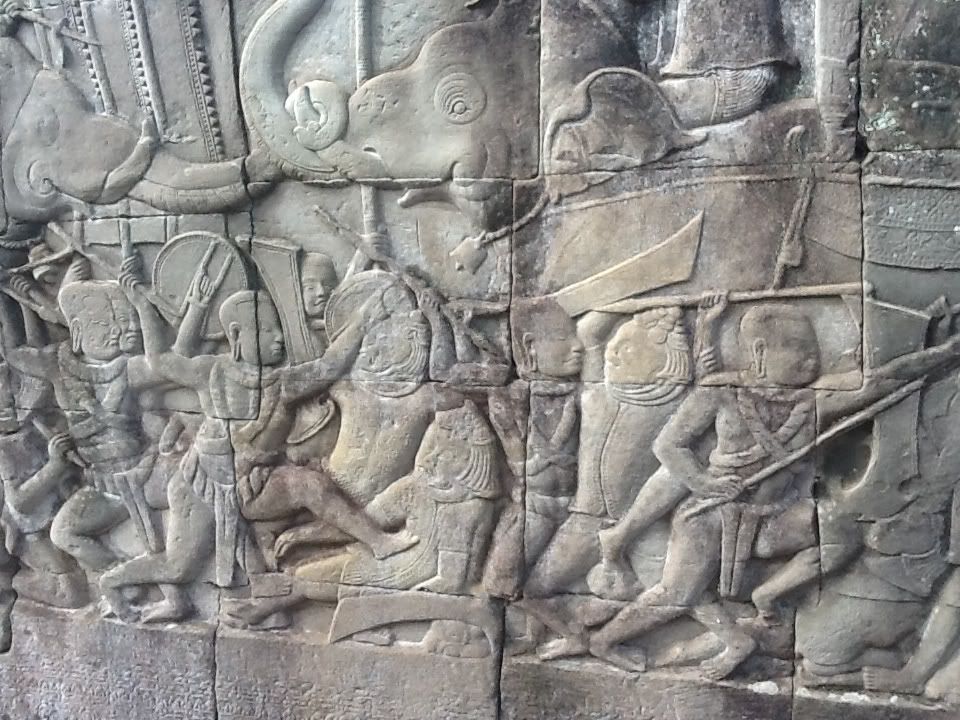
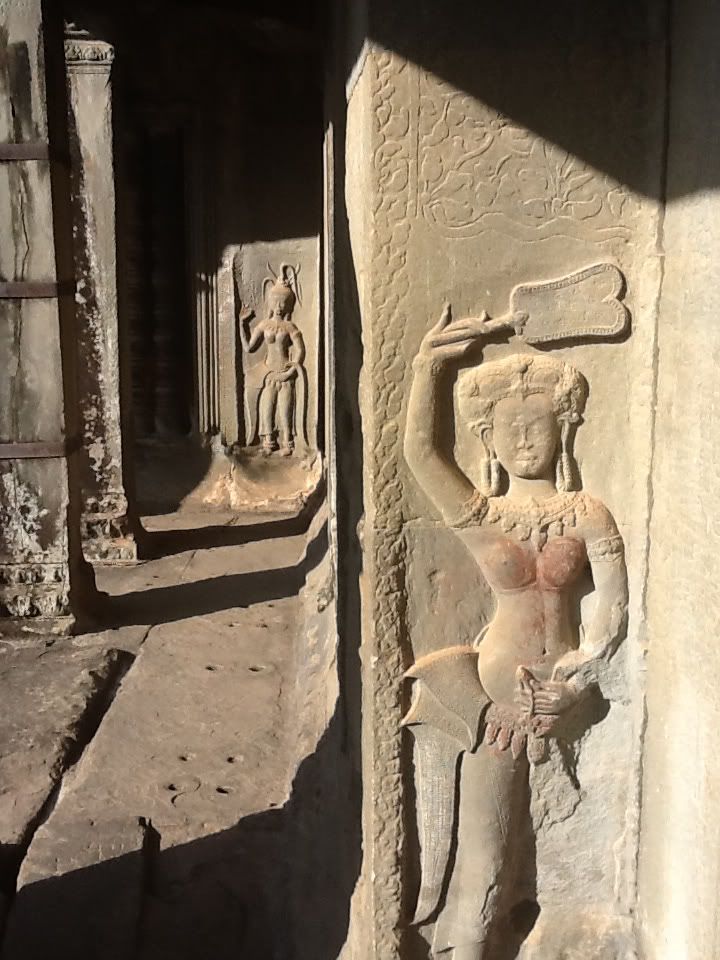
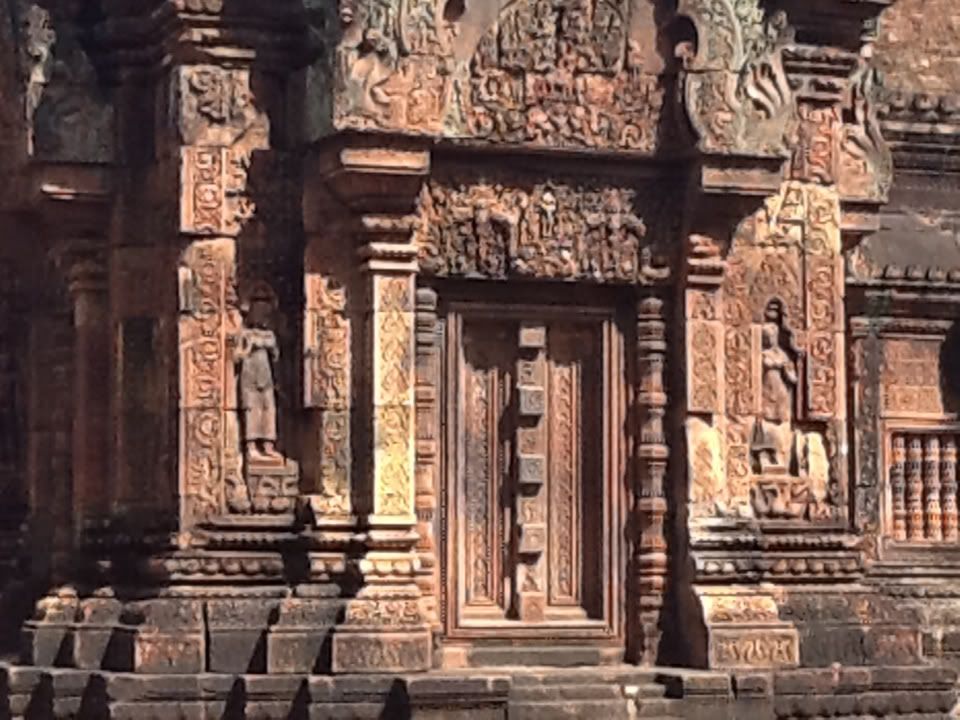
On several temples hundreds of feet of carvings grace the exterior walls. These temples were partially designed to be sites of religious pilgrimage for the masses. Although the general population came, the interior spaces were reserved for the imperial elite. For Hindu temples that would be the Brahmins. For Buddhist temples the elite might be the political elite.
Wall carvings on the outside of the temples, therefore, were meant to appeal to the masses and demonstrate the religious devotion of the Khmer imperial officials.
In a previous post I showed an image from the churning of the sea of milk that is at Angkor Wat.
The first two images are from Bayon Temple. The temple was dedicated after a Khmer king had defeated an army of Cham people from what is now Vietnam about 850 years ago. An enormous detailed wall of carvings depict the various stages of this campaign. It reminded me of Trajan's Column in Rome with similar scale and level of detail.
The next image is from Angkor Wat showing divine female dancers. These images are found all over the temple structures in this area. Traditional Cambodian dance troupes imitate the style of dance represented (but obviously not the dress).
The last image is from a small temple known for its exquisitely detailed carvings from Hindu mythology. The well preserved carvings were delightful since at every turn there was something else to marvel.




Monday, January 2, 2012
Water
The last temple that I visited was the smallest that I have seen. It had been constructed by a Khmer king known as the Leper King about 900 years ago. He mostly likely didn't have leprosy, but he had a fascination with healing waters.
The small temple sits on an island surrounded by a cross-shaped pool. A Cambodian student told me that it is the same shape as the symbol for a hospital, which I found to be an interesting interpretation. The pool itself is in the middle of a larger island which is the center of a huge reservoir of three square kilometers.
In ancient times a drink from the temple pool was viewed as healing. Today the pool looks fetid. A sip seems more likely to cause health problems than cure them.
Even in the rainy season the ancient reservoir typically does not contain water. This year with the historic flooding that I described in an earlier post, water is everywhere. A new boardwalk was built that was never needed before.
Seventy percent of the water in Cambodian rivers comes from China. China has started building huge dams, so this country known paradoxically as the land of water might be in big trouble. The biggest source of protein for this country is from fresh water fish. Dams mean less water, fewer fish, and food insecurity for this impoverished country.
One Cambodian speaking on this topic said that the future of Cambodia will be decided by Chinese dams and the damn Chinese.

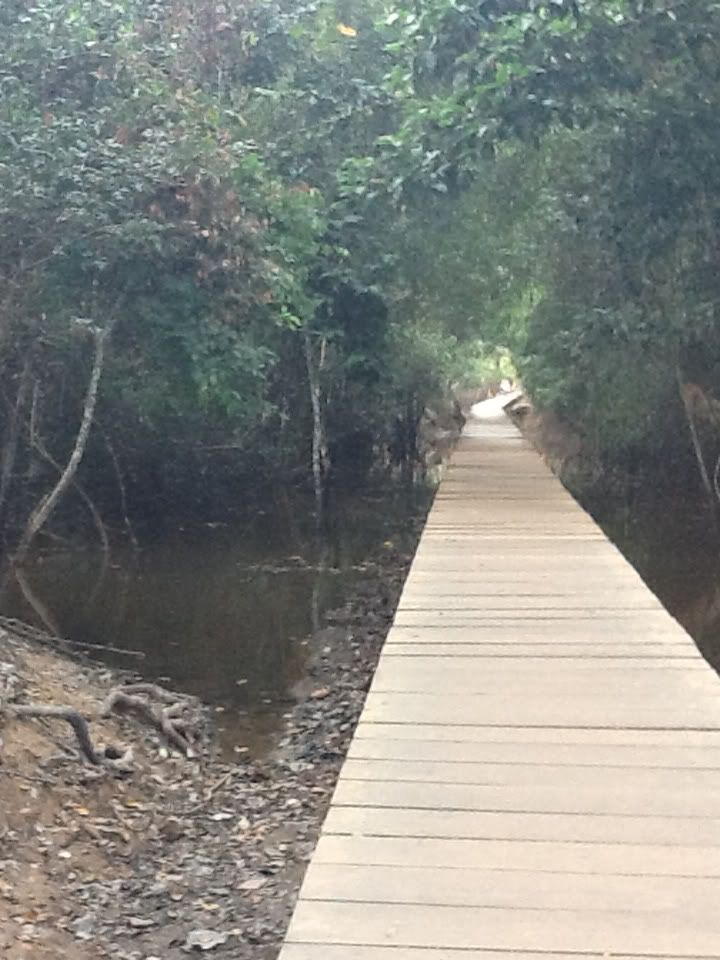
The small temple sits on an island surrounded by a cross-shaped pool. A Cambodian student told me that it is the same shape as the symbol for a hospital, which I found to be an interesting interpretation. The pool itself is in the middle of a larger island which is the center of a huge reservoir of three square kilometers.
In ancient times a drink from the temple pool was viewed as healing. Today the pool looks fetid. A sip seems more likely to cause health problems than cure them.
Even in the rainy season the ancient reservoir typically does not contain water. This year with the historic flooding that I described in an earlier post, water is everywhere. A new boardwalk was built that was never needed before.
Seventy percent of the water in Cambodian rivers comes from China. China has started building huge dams, so this country known paradoxically as the land of water might be in big trouble. The biggest source of protein for this country is from fresh water fish. Dams mean less water, fewer fish, and food insecurity for this impoverished country.
One Cambodian speaking on this topic said that the future of Cambodia will be decided by Chinese dams and the damn Chinese.


More about temples
I have lost count of the number of Angkor temples that I have visited. Most are enormous structures. Many have water features, moats, or sacred pools associated with them.
The temples were places of worship and imperial prominance. Towers reach up to the sky and often whole surfaces are covered in carvings.
The designs are usually symetrical and oriented to all four directions. As one comes up to a temple typically a bridge is crossed, and enclosures lead on to other enclosures. In the center is an especially sacred place.
With the massive scale and numerous small rooms, temples can be very disorienting. For example I toured Angkor Wat with a small group of very experienced historians including some who had been to the site multiple times. We got turned around so much that we lost our sense of direction. Fortunately I was carrying a compass with me at the time (yes, I am an Eagle Scout), and I pointed the way out for our group.
It was not the only time that a compass has come in handy on this trip.
The picture below is me at one of the "lesser temples" near Angkor Wat. You can tell that the scale of these buildings is enormous.
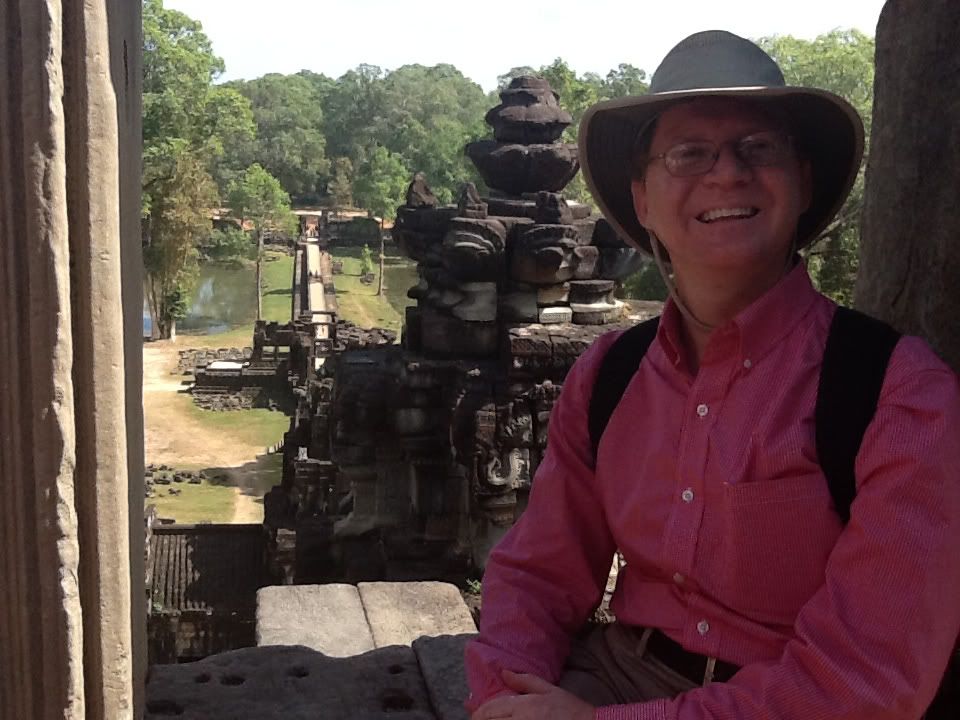
The temples were places of worship and imperial prominance. Towers reach up to the sky and often whole surfaces are covered in carvings.
The designs are usually symetrical and oriented to all four directions. As one comes up to a temple typically a bridge is crossed, and enclosures lead on to other enclosures. In the center is an especially sacred place.
With the massive scale and numerous small rooms, temples can be very disorienting. For example I toured Angkor Wat with a small group of very experienced historians including some who had been to the site multiple times. We got turned around so much that we lost our sense of direction. Fortunately I was carrying a compass with me at the time (yes, I am an Eagle Scout), and I pointed the way out for our group.
It was not the only time that a compass has come in handy on this trip.
The picture below is me at one of the "lesser temples" near Angkor Wat. You can tell that the scale of these buildings is enormous.

Churning the Sea of Milk
In Hinduism one of the stories of creation involves a fairly engaging image.
Two groups of supernatural beings pull on ends of a giant snake that has been wrapped around a log. The base of the log rests on a turtle that is swimming in an ocean of milk. As the stick turns round and round, solids rise up from the milk like butter in a churn. Thus all creation is made.
One of the most famous images of the churning of the sea of milk is on one of the outer walls of Angkor Wat. Also the ancient bridges that lead to temple areas often have sculpted railings with these supernatural beings doing this first "tug of war" with the snake.
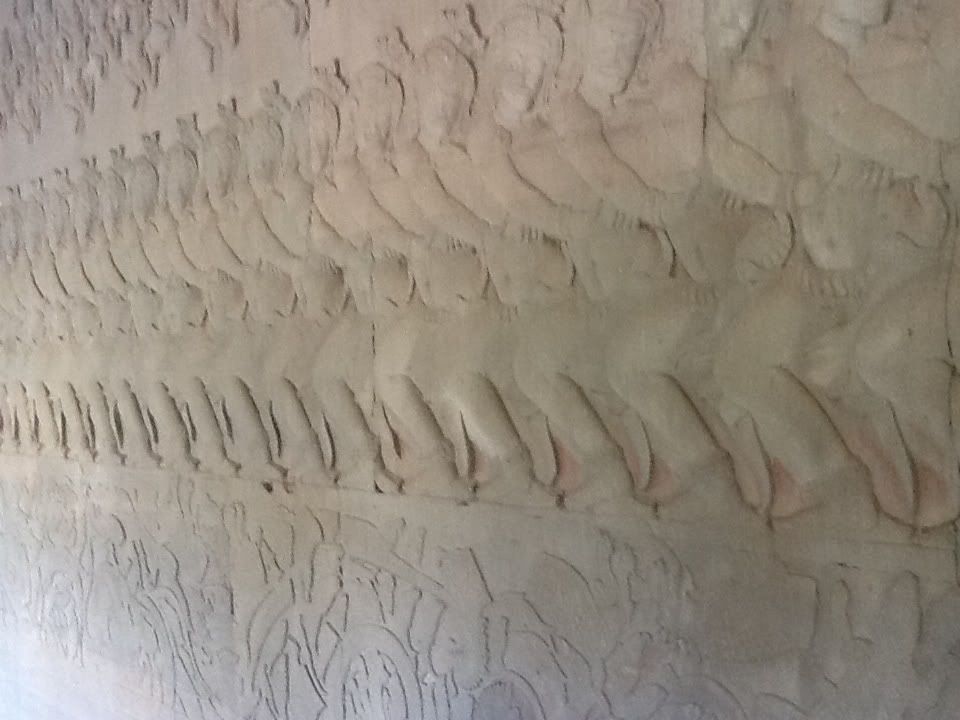

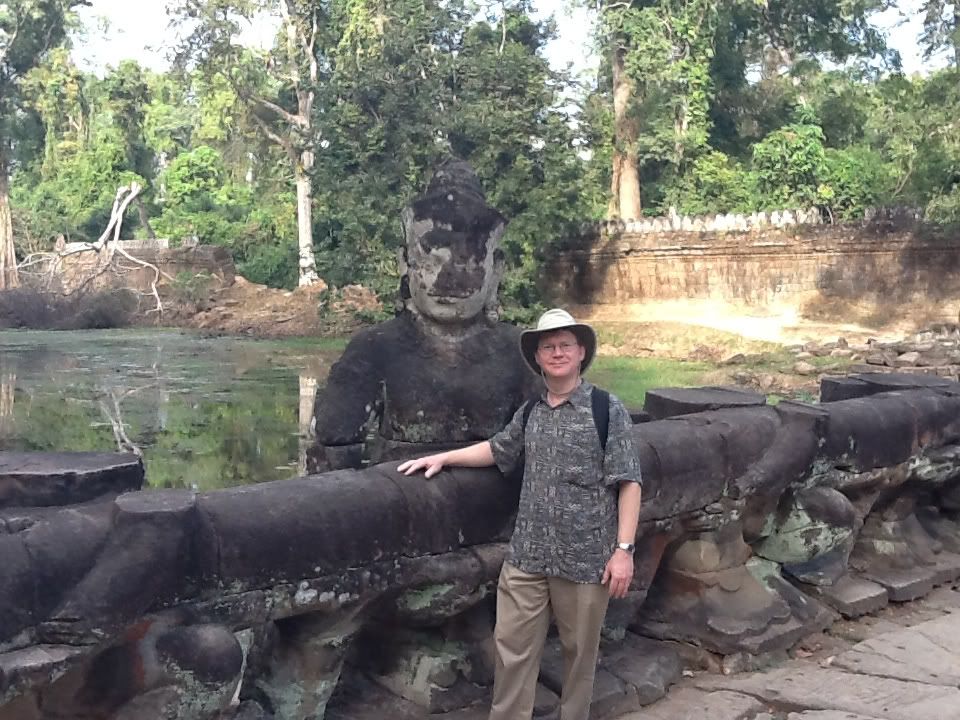
Two groups of supernatural beings pull on ends of a giant snake that has been wrapped around a log. The base of the log rests on a turtle that is swimming in an ocean of milk. As the stick turns round and round, solids rise up from the milk like butter in a churn. Thus all creation is made.
One of the most famous images of the churning of the sea of milk is on one of the outer walls of Angkor Wat. Also the ancient bridges that lead to temple areas often have sculpted railings with these supernatural beings doing this first "tug of war" with the snake.



Subscribe to:
Posts (Atom)
